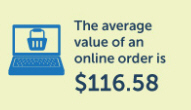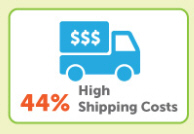In How Can I Improve My Checkout Process?, we noted that the average shopping cart abandonment rate is 66 percent in the overall ecommerce market. This means that 66 percent of the people who find your product and decide to buy it experience a sudden change of heart during the checkout process.
We asked you to imagine this sort of behavior happening at your local grocery store. What if visitors spent 20 minutes shopping in the aisles of a store, placing items in their cart, lining up for the checkout and then suddenly run out the door, abandoning the cart in the middle of the checkout line? What scared them away?
This week’s Ecommerce Eye Candy continues our exploration into shopping cart abandonment with an infographic called Shopping Cart Abandonment Rate Statistics by the Website Optimization company Invesp.
Here are the notables:
How is the average cart performing?
 Conversion rates for all online traffic are a tiny bit above two percent. Cart abandonment rate hovers just around 66 percent, while the average online order is $116.58. It’s important to keep in mind that a B2C company’s average cart value may be much lower, but their customers will have a shorter buy cycle, which means a greater amount of total orders. A B2B cart may typically have a higher cart value, but the buy cycle is longer and orders may be fewer relative to the B2C cart.
Conversion rates for all online traffic are a tiny bit above two percent. Cart abandonment rate hovers just around 66 percent, while the average online order is $116.58. It’s important to keep in mind that a B2C company’s average cart value may be much lower, but their customers will have a shorter buy cycle, which means a greater amount of total orders. A B2B cart may typically have a higher cart value, but the buy cycle is longer and orders may be fewer relative to the B2C cart.
Why do online shoppers change their minds and abandon cart?

44 percent of web buyers who abandon cart do so because of high shipping costs. This might be less of an issue for software merchants, as most digital products are delivered electronically through email or, in the case of SaaS products, accessed through the cloud. But if you cross-sell a physical product like a backup CD, consider incorporating shipping costs into the price of the cross-sell and highlight an offer for free shipping. SaaS companies may find difficulty in incorporating physical cross-sells, though some digital games companies like Zynga have been able to do so. As always, take advantage of multi-variate testing to ensure that your price points and marketing message are optimized.
What is one thing I can change to optimize my checkout process?

This piece of advice applies to most checkouts, even those with just one or two steps: Make sure to display the visitor’s progress along the way. Letting the customer know how many steps are involved at each stage of the checkout process creates a sense of certainty for the customer which makes the process clearer and smoother.
Enjoy the rest of the infographic, and let us know about your interest in shopping cart abandonment in the comment section below

Fantastic info graphic chocked full of interesting stats for an eCommerce nerd like myself! I find it interesting that AOL traffic converts at such a higher rate (50% higher!) than traffic from Google. It’s also really interesting to convert the abandonment and conversion rates against my own stores.
Thanks for the enlightening post! Might be time for further investment in checkout optimization….
Andrew,
Firstly, thanks for the love.
Secondly, the thing to remember about the AOL conversion rate is that while it’s converting 1% better than Google, it brings in 69% less traffic.
If you want to learn more about the variable nature of conversion rates, check out our post, “Conversion Rates: A False Sense Of Security?”
Hi Elan,
First of all, great infographic, its going in my library. I stumbled onto your article via Google search and wanted to ask you a question. I am trying to find data about cart abandonment/bounce rate when people are forced to switch between URL’s aka different websites during a checkout process. It’s clear that it is important to consider when looking at the difference of PayPal Pro and standard or even Facebook keeping you on their site even when searching through Bing. I am curious if you had any solid data on the question. Thank you for your assistance.
Sterling Green
Pingback: Shopping Cart Abandonment: Why? (Infographic) | Pay by Shopping